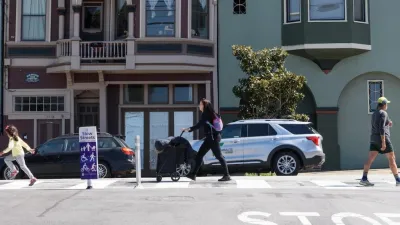The city reduced pedestrian deaths to seven in 2023.

In a piece for Pittsburgh CityPaper, Colin Williams describes how a multi-pronged effort by city agencies and road safety advocates has helped Pittsburgh lower its pedestrian death rate and inch closer to Vision Zero.
“Similar to other civic issues, Vision Zero requires collaboration among agencies that don’t always share the same priorities or systems, including the city government and the relatively new Department of Mobility and Infrastructure (or DOMI, created in 2017); advocacy groups like BikePGH and Pittsburghers for Public Transit (PFPT); PennDOT; and the Pittsburgh Bureau of Police,” Williams writes. For example, roughly half of the 10 percent of roadways where the vast majority of deaths and major injuries occur are managed by PennDOT.
Williams outlines the various tools and databases that PennDOT and local agencies use to aggregate crash data and understand where the most incidents occur and what safety interventions have the biggest impact. “As the city moves ahead with a proposed red-light camera program, many such interventions have gone in, including the two-way conversion of the former Penn Circle, traffic calming along streets such as Stanton Ave. and Grandview Ave., and pedestrian safety installations in Central Lawrenceville. The city continues to install leading pedestrian interval signals at crosswalks that give walkers and rollers a headstart on motorists.”
FULL STORY: Ending pedestrian deaths in Pittsburgh is a team effort

Alabama: Trump Terminates Settlements for Black Communities Harmed By Raw Sewage
Trump deemed the landmark civil rights agreement “illegal DEI and environmental justice policy.”

Planetizen Federal Action Tracker
A weekly monitor of how Trump’s orders and actions are impacting planners and planning in America.

Why Should We Subsidize Public Transportation?
Many public transit agencies face financial stress due to rising costs, declining fare revenue, and declining subsidies. Transit advocates must provide a strong business case for increasing public transit funding.

Understanding Road Diets
An explainer from Momentum highlights the advantages of reducing vehicle lanes in favor of more bike, transit, and pedestrian infrastructure.

New California Law Regulates Warehouse Pollution
A new law tightens building and emissions regulations for large distribution warehouses to mitigate air pollution and traffic in surrounding communities.

Phoenix Announces Opening Date for Light Rail Extension
The South Central extension will connect South Phoenix to downtown and other major hubs starting on June 7.
Urban Design for Planners 1: Software Tools
This six-course series explores essential urban design concepts using open source software and equips planners with the tools they need to participate fully in the urban design process.
Planning for Universal Design
Learn the tools for implementing Universal Design in planning regulations.
Caltrans
Smith Gee Studio
Institute for Housing and Urban Development Studies (IHS)
City of Grandview
Harvard GSD Executive Education
Toledo-Lucas County Plan Commissions
Salt Lake City
NYU Wagner Graduate School of Public Service





























